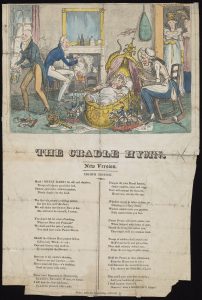January 6, 2020, by Kathryn Steenson
Georgian Delights
When King George IV died in June 1830, The Times asked, ‘What eye has wept for him? What heart has heaved one throb of unmercenary sorrow?’.
George was a controversial figure throughout his lifetime (1762-1830). As Prince of Wales, after 1783, George became notorious for his frequent love affairs and lavish self-indulgence, spending wildly on gambling, fashion, and architecture. He became infamous as the creator of Brighton Pavilion, which Lady Frances Bentinck described in 1821 as ‘the offspring of a Marriage between a Mosque and a Pagoda’. His politics were opposed to those of his father, King George III, whom he offended by contracting a secret (and illegal) marriage with the Catholic Maria Fitzherbert. However, George’s Whig political friends felt betrayed when, as Prince Regent after 1811, he continued his father’s Tory ministers in office.
By the time that George IV succeeded to the throne, as King of the United Kingdom of Great Britain and Ireland and King of Hanover, at the end of January 1820, he was a figure of fashion and fun, famous for his outlandish outfits, close circle of friends (including the famous Regency ‘dandy’ Beau Brummell), and racy love life.

‘God save our lord the King’, Gentleman’s Magazine (London, 1745).
In 1745, The Gentleman’s Magazine published ‘God save our lord the king: A new song set for two voices’. It was sung in support of King George II (1683-1760) during the Jacobite Rebellion of 1745. By the time that George IV became King in 1820, it had been adopted as a national anthem. It is ever so slightly different from the modern version.
As the exhibition Georgian Delights. Life During the Reign of George IV (1820-30) demonstrates using material from the University of Nottingham’s Manuscripts and Special Collections, George IV inherited his throne at a dangerous time. The end of the Napoleonic Wars in 1815 was followed by five years of domestic political turmoil, including the infamous ‘Peterloo Massacre’ of 1819. Within a month of becoming King, a plot to assassinate the cabinet was uncovered (‘The Cato Street Conspiracy’), whilst revolutions in Europe, and George’s own disastrous marriage with Caroline of Brunswick, became headline news. George was determined that Caroline should not become Queen Consort and unsuccessfully attempted to divorce her, by way of a ‘Bill of Pains and Penalties’ which was debated in the House of Lords. Caroline became a rallying point for the discontented, whilst George became an object of hostility and ridicule for humourists like William Hone and caricaturists including George Cruikshank and John Doyle.
The exhibition highlights Catholic Emancipation as a major political event during George IV’s reign. It was achieved by peaceful pressure from Daniel O’Connell’s Catholic Association in the face of ultra-Protestant opposition from Tory aristocrats like the 4th Duke of Newcastle. Newcastle, who carried ‘Curtana’, the sword of mercy, at George IV’s coronation in 1821, was one of many individuals who attempted to bolster George’s opposition to Emancipation – the right for Catholics to sit as Members of Parliament.
Displays also highlight the precarious state of the succession to the throne. George and Caroline’s only child, Princess Charlotte of Wales, died in 1817, whilst the ‘Grand Old Duke of York’ (of nursery rhyme fame) died a decade later. It was left to George’s younger brother, William, Duke of Clarence, to steer Britain towards a decade of Reform, as King William IV.
With satirical images, lavish coronation ceremonial, political pamphlets, polite music, and mementos of the golden age of coaching, the exhibition offers a fascinating insight into a King who is better remembered as a celebrity, rather than a serious monarch.
To accompany the exhibition, there are a series of talks, behind-the-scenes gallery tours, and a screening of the 1954 film Beau Brummell. Tickets can be booked through Lakeside Arts Box Office. To see the original archives and rare books, please contact Manuscripts and Special Collections on mss.library@nottingham.ac.uk to make an appointment to visit the Reading Room.
No comments yet, fill out a comment to be the first


Leave a Reply